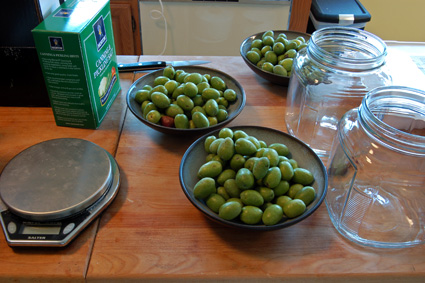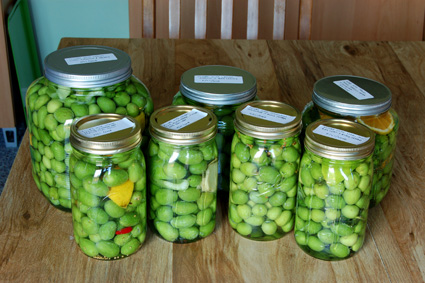There are all manner of foods that, upon reflection, seem unlikely or even impossible candidates to make that leap from "thing out there in nature" to "tasty and delicious comestible".1 Cassava - also known as manioc and yuca, and which provides us with tapioca - comes to mind, since it's chock full of delightful prussic acid, or hydrogen cyanide, and requires a combination soaking and heating processes to make it safe to eat. Or the cow, which in its ancient form, the aurochs2, seems a little less dangerous to hunt than a rhinocerous, and only marginally more domesticable.
Or the olive. The humble olive, fruit of Olea europaea:

Oval-shaped, speckled green, and definitely on the so-bitter-this-isn't-food side of the fence. Karl, my olive-curing partner, and I each tasted just a little bit of fresh, unripe olive, which left a lingering bitterness at the back of the mouth for at least five or ten minutes. A whole green olive, I've heard, can have enough oleuropein to keep you stocked in mouth-tingling bitterness for several hours. Even after the bitterness went, the tingling sensation lingered at the back of the roof of the mouth, the very same cough-inducing tingle that you get from good, fresh olive oil.
Incidentally, that little bite of olive tasted a lot like raw dandelion greens, or any other wild, bitter green. Not bad, per se, but definitely something to be had in moderation, and not by itself. And not as fiercely bitter as the Tylopilus felleus mushrooms I found back in July, which all but screamed not to be eaten.3 The bitterness didn't come on at first, but swelled and then faded. Neither of us felt the need to go back for seconds.
Bitterness, in olives and pretty much all other plants, is a way of communicating the message not to eat. It's less common in fruit than in leaves, for example, because an appealingly tasty fruit is more likely to find a hungry animal to help disperse the seeds. For olives, however, bitter fruit works. Their preferred seed dispersers are birds, which swallow the olives whole; we mammals chew before swallowing, which can damage the seed, especially in a fruit with just one large, central seed.
Olea europaea seems to have a rather good story of evolutionary success, due in no small part to humans. Oleasters, the wild trees, supplied occasional food for neolithic hunter-gatherers 10,000 years ago; Alan Davidson describes fully ripe olives as "relatively free of bitterness", which I suppose was good enough. Evidence of olive mills and presses, as well as cultivation, dates back to before 3,000 BCE. It's quite likely that these oily little fruit - up to 30% of the flesh - were originally used for just their oil, for cooking and for lamp fuel. Even today, 90% of the world's crop is destined for olive oil.4
So they're useful trees. Long-lived, too. Harold McGee notes that they're hardy, drought-tolerant, and can live and bear for a thousand years. Though severe cold will kill them - severe frosts in Provence in 1870 and 1956 did massive damage - they can survive in Mediterranean-like climates wherever they're found. I used to sit and read under them in central Arizona, and can say that they're quite possibly the loveliest, most graceful trees I've ever seen.
In addition to being useful, they've also done serious ecological damage, following overplanting - some government-forced in the ancient Mediterranean - which put olives everywhere they'd grow. To the exclusion of plenty of other plants and animals, of course.
Back to the matter at hand. Olives can be harvested anywhere from green - unripe, hard, and bitter - to purplish-black - ripe, soft, and still bitter, but not so much. To alleviate the bitterness, there are several methods that may be used alone or in combination:
- Water-curing, which requires repeated soakings and rinsings to leach out the bitter oleuropein. Repeated, as in over several months.
- Brine-curing, which is a fermentation process in salt brine that can take from one to six months to complete.
- Dry-curing, which involves packing the olives in salt to cure, much like making preserved lemons, I suppose.
- Oil-curing, which can mean soaking in oil (presumably olive) for several months, or can mean dry-curing olives, followed by a rubbing with oil.
- Lye-curing, which uses a highly alkaline solution to extract the oleuropein.
Unlike lye-curing. The Romans would sometimes add wood ash to their olive brine to speed the process, though today's processors use straight-up lye. Ask your extension agent (if you live on California olive country) about home curing, and that's the method they'll give you. I don't know about you, but high-octane drain cleaner doesn't strike me as the best thing for food preparation. After all, the warning information includes fun little tips, like:
- "Avoid all contact with organic tissue (including human skin, eyes, mouth, and animals or pets). Keep away from clothing. Avoid all contact with aluminum."
- "...may cause chemical burns, permanent injury or scarring, and blindness."
- "...may react with various sugars to generate carbon monoxide..."
- "Solvation of sodium hydroxide and/or potassium hydroxide is highly exothermic, and the resulting heat may cause heat burns or ignite flammables."
Karl and I, not eager to disfigure ourselves for the sake of a martini garnish, have elected to go with the brine option. In short, it went like this: fill glass jars of various sizes with olives and flavorings; add a bit of vinegar (optional); cover in a brine strong enough to float an egg; put a layer of oil to cover; seal (but not too tightly); wait. Six months, we think, which conveniently runs from equinox to equinox. The last step, of course, is to eat them, preferably at a party with lots of olives and martinis to go around.
I should mention that we've branched out in terms of flavorings, and Karl more so than me, in part because he used a number of much smaller jars.5 We used citrus - lemons, limes, oranges - as well as hot peppers of various sorts, garlic, celery, herbs, ginger, and two pantries' worth of spices. I remember using bay leaves, black pepper, coriander, mustard seed, cinnamon, and possibly others. Sumac, allspice, cardamom, star anise, and cloves were others that might be flavoring one or more jars, because I remember discussing them. All options were open, and we'll see how they pan out. Fortunately, we had the good sense to label everything for our future benefit.

Will it work out? I have no idea. The jars are busy fermenting - actually bubbling away - down in the fermentarium, so I'm excited. And in six months' time, if the fickle and mighty fermentarium spirits smile down6 upon us, there will be much rejoicing. And martini consumption.
* * * * *
1Not even counting things - usually animals - that are especially poisonous or otherwise deadly, like fugu, the pufferfish, where extensive training is needed to separate the edible flesh (for sushi) from the highly toxic liver. Or poisonous snakes, such as rattlesnake and cobra, which hardly seem worth the effort.
2Though I wish we called it the "Ur-Ox", since that may be where "aurochs" comes from. A much more impressive name for a giant - supposedly almost six feet at the shoulder - and aggressive beast that gave Julius Caesar and his Roman legions pause.
3I didn't eat them, of course. Just the briefest touch of the tongue was worse than a bite of olive, and immediately. Yarf.
4Table olives and oil olives come from different varieties, though I imagine you could interchange them if you wanted to. The result might not be as ideal, but if you find yourself in sudden possession of an olive grove, you might as well put it to good use.
5He had a dozen 12 oz. or pint jars, and borrowed a few quarts from me. I have a total of four quarts; two half-gallons; and one gallon jar, all packed full.
6Or is it up? They live in the basement, after all, so the highest they could be isn't much above eye level.
